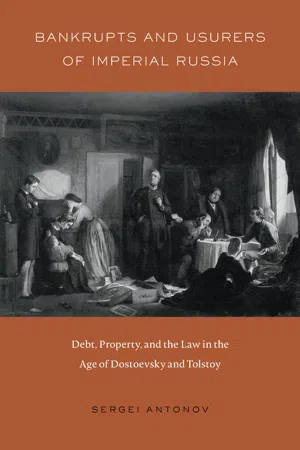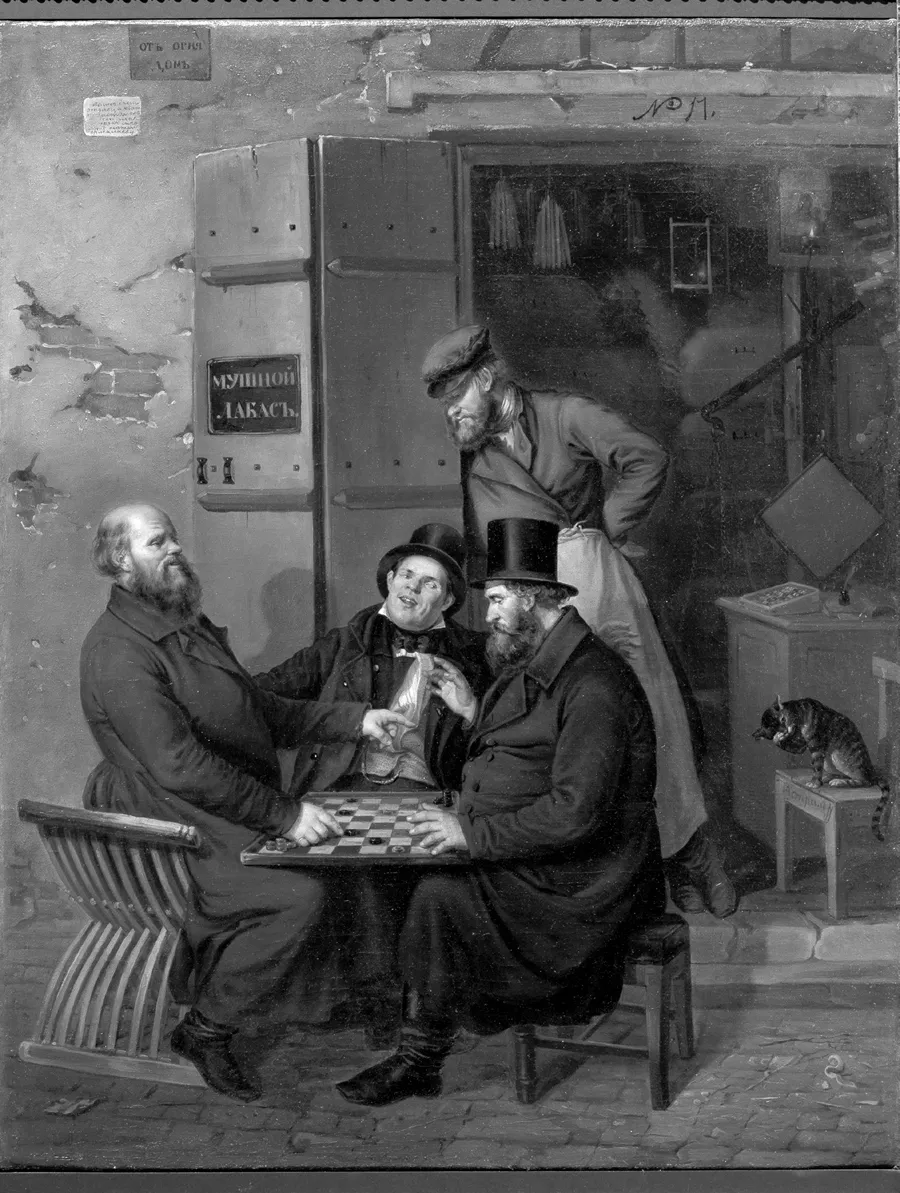CHAPTER 1
Usurers’ Tales
This of course describes Aliona Ivanovna, the fictional pawnbroker from Crime and Punishment. The university students and young army officers who were her clients said that she was “able to hand out five thousand all at once, while never snubbing a ruble’s pawn.”2 The most striking element of the cultural stereotype captured by Dostoevsky is not simply Aliona Ivanovna’s pathetic appearance or viciousness but also her social marginalization, which is exaggerated to the point of caricature. Her only known social interaction is to bite her half-sister Lizaveta, her clients appear as parasitical as herself, and her wealth would remain lost to society even after her death by being bequeathed to a remote monastery.3 Consider also Grushenka, the femme fatale of Dostoevsky’s last great novel, The Brothers Karamazov:
To Dostoevsky’s early readers, this passage would illustrate the moral defectiveness of both Grushenka and the soon-to-be-killed Fedor Karamazov because individuals who bought up bad debt and then used their knowledge of legal procedures to collect it were known as diskontery (for “discounting” a debt document, which means buying it from the original lender for less than its face value) and considered to be “the most greedy and predatory” type of usurer.5
Real-life Russian moneylenders and pawnbrokers, in contrast to their prominent fictional counterparts, were hardly ever discussed in the press or remembered in memoirs, even when they were murdered. Even imperial-era works on rural usury, such as those by Roman Tsimmerman (Gvozdev) and Georgii Sazonov, provide detailed information about credit networks and lending practices but very little information about lenders as human beings as opposed to abstract economic actors. These authors show wealthy peasant lenders (known as kulaks) as fundamentally in opposition to their communities even while arguing that any peasant would gladly turn into a kulak if given a chance. Incidentally, this point also applies to histories of credit in Western Europe and North America, which are written entirely from the debtors’ perspective.6
Similarly, Marx’s framework, which guided the few brief explorations of “usury” by Soviet historians, equated private informal lending with the archaic “usurious” variety, which he interpreted as predatory and nonproductive and therefore not worthy of a detailed analysis except as the backdrop for the development of modern capitalist banking. The data presented in the few Soviet-era studies of “usury” in early modern and Petrine Russia do not at all fit this theory, showing that although credit could indeed be expensive and even exploitative, the web of credit ties linked all social strata, and private lending could not be characterized as unambiguously or predominantly predatory or archaic or as financing mainly wasteful consumption.7
Nineteenth-century lenders likewise were a diverse group, ranging from the wealthiest aristocrats to illiterate peasant pawnbrokers, and from a multitude of one-time investors to a few individuals who can be characterized as professional usurers. It is as difficult to single out the latter group of high-risk lenders as it is to identify the rates they charged. Moreover, even “professional” lenders still depended not upon Aliona Ivanovna–style hostile estrangement from the world but upon being successfully embedded in existing networks of kinship, state service, and locality. Like the motley group of entrepreneurs who prepared the way for Russia’s capitalist transformation or the jurists who prepared the legal reform, these individuals—who had to fit in in the absence of large banks—prepared the way for the Russian financial revolution that began in the 1860s.
Equally importantly, lenders relied on their knowledge of legal rules and procedures. Their legal knowledge and skill level varied but nearly always made the laws limiting maximum interest rates practically unenforceable except in rare circumstances.8 The task of upholding private property and supporting the elites who owned it required the security of private-law transactions, including loans and mortgages, even though actual interest rates exceeded the legal limit. This contradiction potentially subverted the tsar’s law and his officials’ authority and caused no small concern to the latter. Governors, police officers, and jurists needed to determine whether they could effectively regulate private credit and, if so, where to start. For instance, how were they to gather the necessary information, and how were they to justify their intervention in legal, political, and moral terms? Provincial governors with their extensive police powers, and the officers of the Third Section of His Imperial Majesty’s Own Chancellery—Russia’s political police in 1826–1879, with broad authority to monitor and regulate public morality—did find the time in their busy schedules to examine private lending by conducting surveillance operations that were remarkably sophisticated for the mid-nineteenth century and by gathering and responding to individual complaints and secret reports about individual lenders. In the process, officials had to make important judgments about such things as individual authority, responsibility, and failure and, above all, about the tension between morality and the law.9
Whereas the authorities suppressed political dissent quite rigorously and had no qualms about using agents provocateurs and secret informants to sniff out other kinds of organized crime, I have not located any instances of similar kinds of entrapment being used to catch usurers. Virtually all private lenders were left unmolested, with the exception of a few individuals perceived as not playing by the rules, such as by offending powerful interests or attracting an unusually high volume of complaints. If possible, these were prosecuted in court, but more commonly the government combined out-of-court negotiations and extra-legal—or, rather, quasi-legal—sanctions, including police surveillance and administrative exile. Ultimately, none of these measures could satisfactorily address deep-seated anxieties about the morality of the market and the government’s role in regulating it, but then what could?10
Morality, Policy, and the Law
Dostoevsky’s deep aversion to moneylenders was fueled by his well-known personal experiences with debt, but ultimately it was grounded in a longstanding cultural and religious tradition extending far beyond Russia. Aristotle condemned usury as unjust and unnatural because “interest was money born of money,” and money was an arbitrary medium of exchange that was not supposed to breed. The Biblical and Christian denunciations of usury could be interpreted as allowing it under certain circumstances but still considering it incompatible with life in a peaceful community.11 The most common Russian word for usurer—rostovshchik—was a term of abuse that could easily lead to a lawsuit for insult and slander.12 A brief anonymous tale from the late seventeenth century depicted a usurer who died and fell directly into hell when he was buried; his lot was improved after his widow donated all of his wealth to the church and to the poor, but only after long negotiations and with the participation of a folk minstrel (skomorokh). The devil in this tale—vicious and mistrustful—appears to be little different from the usurer himself, and the negotiations closely resemble the procedure of collecting a debt.13 In nineteenth-century fiction, for example in Nikolai Nekrasov’s 1841 short story, usury involves a “hardening” of one’s soul and is associated with vengeance and sexual predation: the lender enticed his victim, a skilled but modest artisan, with an interest-free loan just so he could eventually engineer his ruin and attempt to possess his wife.14 In our own day, it is commonly accepted by economists and laypersons alike that low interest rates reflect a nation’s “intelligence and moral strength.”15
Occasionally, oppressed debtors took matters into their own hands. The barely veiled threat of popular violence is expressed in one of Ostrovskii’s plays published in 1872, in which a character from Moscow’s lower middle class opines that “these usurers should be robbed, my friend, because thou shalt not drink another’s blood.”16 After public criminal trials were introduced in Russia in 1866, several notorious cases involved the murder of a usurer by his or her client: only weeks before the first installment of Dostoevsky’s Crime and Punishment was published in 1866, a Moscow University student, Danilov, killed a usurer and her servant.17 In 1879, another prominent usurer, Vlasov, was murdered in St. Petersburg by his client and friend, Karl Landsberg, an officer in the Imperial Guard, who became worried that the lender intended to ruin his upcoming marriage by revealing his precarious financial condition. After slitting the usurer’s throat with a razor blade and then killing his maidservant as well, Landsberg found out that Vlasov had just written a letter forgiving all his debt as a wedding present.18
More coordinated attacks were also possible, especially when a lender happened to be in a vulnerable position. In 1864, a sixty-four-year-old merchant and moneylender, Andrei Lukin, was imprudent enough to visit the inner chambers of the Moscow debtors’ prison. He was attacked by a group of inmates, who beat him, called him a scoundrel (podlets) and a usurer, and told him in the presence of a police officer who was helpless or unwilling to intervene that he was being beaten for “charging a very large and merciless interest rate, namely fifteen percent per month.”19 Rural usurers risked a visit from robbers and highwaymen. In 1838, a gang of approximately twelve men led by an escaped convict broke into the house of Mr. Glinka, a rural landowner in Smolensk province. Glinka, who lived in a dilapidated house with only three girls and one boy as his servants, was known for his wealth and miserliness. The robbers had no difficulty breaking the rotten window frames and subduing the servants, after which they took away a chest containing pawned property and cash.20
The majority of the population who were law-abiding took their grievances to the authorities. Popular complaints about usurers preserved in legal and official documents show no awareness of ancient philosophical arguments, such as the Aristotelian critique of usury as unnatural and unjust. Nor were the Biblical and Christian denunciations of usury of much help: early modern Russia had a centuries-long tradition of interest-bearing lending that was pioneered by its greatest property owner, the Orthodox Church.21 Finally, it was futile to claim that moneylenders were useless parasites similar to Aliona Ivanovna because, much as we might admire the art of Dostoevsky, Ostrovskii, and Nekrasov, real-life usurers were exceedingly well integrated into society, generally much more so than their clients. Consider the well-known memoirs by Elizaveta Yankova (1768–1861) recorded by her grandson Dmitry Blagovo. One of Yankova’s relatives, a girl from the old Muscovite Mamonov family, married an old and wealthy moneylender, Stepan Shilovskii. His craving for money allegedly resulted in chest spasms whenever someone would come to ask him to pay household expenses, and apparently he eventually died from despondency after losing a large investment.
The narrator noted that even if these stories were not true, they still showed that Shilovskii was thought to be capable of severe depression on account of money, something apparently considered bad form among old gentry families.22 Reading this passage, it is easy to miss the fact that Shilovskii, described as a stereotypical miser found in fiction throughout the world, was nonetheless deeply and comfortably entangled in the network of kinship, property, and influence that Yankova’s memoirs describe so vividly. Indeed, Shilovskii’s son Peter rose to become a member of Russia’s Council of State.23 His daughter Anna married a member of the prominent Voeikov family but apparently continued his father’s occupation as a moneylender and a woman of business.
Rather than condemning usury as such, the typical victim’s narrative submitted to the courts or to the police alleged excessive avarice and shrewdness that preyed on personal misfortune and subverted the tsar’s law through its loopholes and imperfections. For example, a civil servant in Petersburg, Grigorii Popov, complained to the police in 1859 that
In fact, Yefimov sued for the entire amount only one month later, but there was virtually nothing a borrower like Popov could do to defend himself when a usurer had followed the letter of the law.
A more persuasive set of arguments against usury invoked societal interest and came both from the victims and from police officials. For example, this is how one Mosc...

